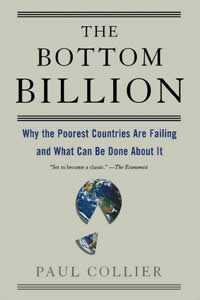 “The Bottom Billion” is a fascinating study of the poorest countries in the world. Paul Collier, a former official with the World Bank, is one of the world’s leading experts on African economies. He has worked with, and studied, the dynamics that keep a country down.
“The Bottom Billion” is a fascinating study of the poorest countries in the world. Paul Collier, a former official with the World Bank, is one of the world’s leading experts on African economies. He has worked with, and studied, the dynamics that keep a country down.
Collier says the previous paradigm was one billion people in rich countries and five billion in poor countries. But now, he says, “We must learn to turn the familiar numbers upside down: a total of five billion people who are already prosperous, or at least are on track to be so, and one billion who are stuck at the bottom.”
The bottom billion consists of people in 58 countries. “Their reality,” he writes, “is the 14th century: civil war, plague, ignorance.” Africa is the main problem, but some such countries exist in Central Asia.
Collier and his colleagues and students (he teaches Economics at Oxford) have done gobs of empirical studies which shed light on the problems of the bottom billion. Being a good academic, he warns you when he uses results which haven’t been subjected to peer review, and therefore shouldn’t be taken as gospel.
Collier examines four characteristics common among the bottom-billion countries.
1. Going through a civil war. The poorer the country when conflict starts, the longer it lasts. After going through a civil war, the risk of going through another one doubles. Only half of the countries in which a conflict has ended manage to make it through a decade without relapsing into war. The poorer you are, the great the risk of relapse.
2. The predominance of revenue from natural resources. Sierra Leone’s economy, for instance, is dominated by diamonds; politicians fight and maneuver to get their fingers in that pot. With so much attention focused on natural resources, other types of business are never nourished. The country becomes a one trick pony.
3. Being landlocked with bad neighbors. Many African countries have no access to the sea–Mali, Niger, Chad, Uganda, Zambia, Botswana, Rwanda, Burundi, and others. Landlocked countries rely on having good neighbors, who either provide access to the sea or provide a good market. Switzerland, though landlocked, is surrounded by its market–healthy countries like Germany, Italy, and France. But Uganda is stuck with Kenya, which has no incentive to build roads to Uganda and has too many problems to be a good market for anything produced in Uganda.
4. Bad governance and poor economic policies. Such countries can’t attract investment capital, because they are perceived as a poor risk. With no opportunities, educated, quality people leave to seek their way in other countries. Rebel or coup leaders, upon seizing power, put fellow soldiers into important government posts, with responsibility over areas they know nothing about, resulting in increased dysfunction and corruption.
Collier also hit other aspects of this subject, such as the use, and misuse, of foreign aid. And in a
surprising chapter, he presents excellent arguments for military intervention in
certain circumstances.
The book is filled with fascinating insights backed by statistical research. I gained a fresh and deep understanding of why bottom-billion countries tend to stay at the bottom.


 “The Bottom Billion” is a fascinating study of the poorest countries in the world. Paul Collier, a former official with the World Bank, is one of the world’s leading experts on African economies. He has worked with, and studied, the dynamics that keep a country down.
“The Bottom Billion” is a fascinating study of the poorest countries in the world. Paul Collier, a former official with the World Bank, is one of the world’s leading experts on African economies. He has worked with, and studied, the dynamics that keep a country down. After taking command in 2007, General David Petraus wrote a letter on “Values” to all of his soldiers.
After taking command in 2007, General David Petraus wrote a letter on “Values” to all of his soldiers.  Yon (left) superbly pictures the principles of counter-insurgency in action. You really need to see these principles lived out to appreciate them. Thomas Ricks talks about counter-insurgency theory in “Fiasco,” which ends just as David Petraus is taking over, and he describes a couple major success stories–one in 2003 when Petraus commanded the 101st Airborne in Mosul, and then later in Tal Afar (both of which were basically rogue operations by individual commanders who “got it”). But counter-insurgency principles permeate Yon’s book, and you can’t help but realize, “We should have been doing this all along.” Yon, as a Green Beret, was trained in these principles, so he understands what he’s looking at.
Yon (left) superbly pictures the principles of counter-insurgency in action. You really need to see these principles lived out to appreciate them. Thomas Ricks talks about counter-insurgency theory in “Fiasco,” which ends just as David Petraus is taking over, and he describes a couple major success stories–one in 2003 when Petraus commanded the 101st Airborne in Mosul, and then later in Tal Afar (both of which were basically rogue operations by individual commanders who “got it”). But counter-insurgency principles permeate Yon’s book, and you can’t help but realize, “We should have been doing this all along.” Yon, as a Green Beret, was trained in these principles, so he understands what he’s looking at.
 I gotta agree with Chief Justice John Roberts in regard to the State of the Union Address–how it’s become a political pep rally. The justices sit there surrounded by hooting and hollering Congressmen, and are by tradition expected to remain stone-faced, expressionless–even as the President criticizes them for a recent decision.
I gotta agree with Chief Justice John Roberts in regard to the State of the Union Address–how it’s become a political pep rally. The justices sit there surrounded by hooting and hollering Congressmen, and are by tradition expected to remain stone-faced, expressionless–even as the President criticizes them for a recent decision. 


